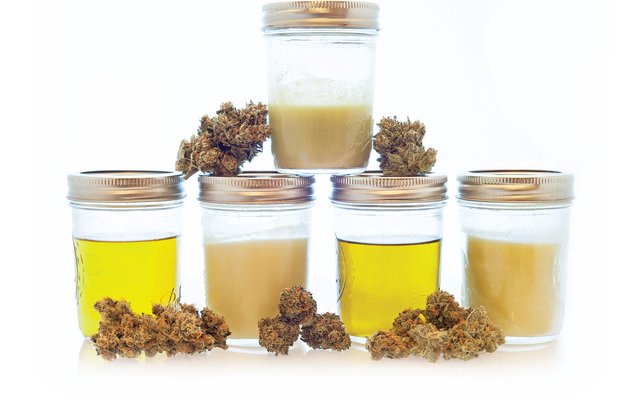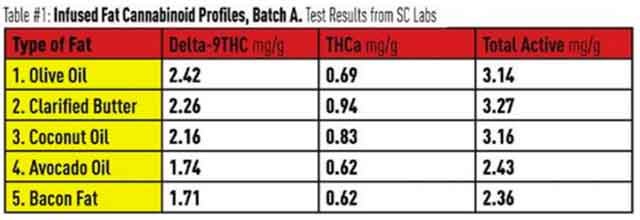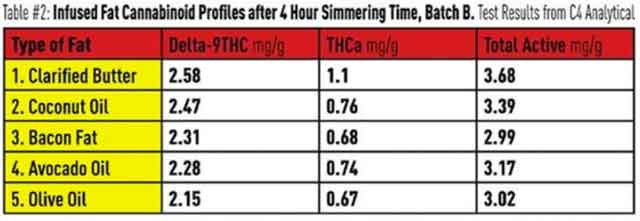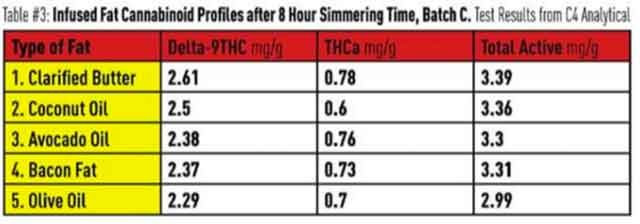WHICH FAT ABSORBS THC BEST?

Hello Steemit Users! How is your day? So for those who already tried to do some weed butter to make a cake or other plates, I know you've probably been wondering which fat absorbs THC the best. I found an article from Hightimes.com, answering to some questions you may have about this. I'll put the link to the source at the end of the post.
So here is what the article on Hightimes is saying:
"When extracting THC for use in cooking, both stoner lore and hard science tell us that fats make the best mediums for potent infusions. But what type of fat should you use to extract THC most efficiently?
To find out, I devised an experiment comparing the total potency of five different fats—butter, olive oil, avocado oil, coconut oil and bacon fat—after they were infused with the same amount of cannabis in the same exact way.
Because cannabinoids and fats are both hydrophobic, THC molecules dissolve readily in lipids when they’re heated together in a solution. And this friendly relationship continues in your body, where everyone’s favorite psychedelic molecule takes up residence in your adipose tissue and remains there for 30 days or more. This long-term bonding in your “phatty” tissue is the reason you can still fail a drug test a full month after the last time you got high. It’s also the reason runners sometimes report copping a buzz from burning their own THC-laden fat for energy during a long run, making marijuana the gift that keeps on giving.
Among home cannabis cooks, butter is clearly the most common fat used for THC infusions, but over the last few years I’ve encountered (both in real life and online) an increasing number of amateur edibles-makers who espouse a strong preference for coconut oil, attributing their own most potent infusions to its unique chemical makeup. Anecdotal evidence also suggests that saturated fats, such as butter, bacon fat and coconut oil, absorb THC better than monounsaturated fats like olive oil and avocado oil, but to my knowledge this experiment is the first serious attempt to scientifically test that hypothesis.
Odor-Proof Infusions
Anyone who makes cannabis infusions at home knows that the process seriously stinks up the entire house with the unmistakably dank and earthy reek of weed, which can cause problems with your roommates, family or neighbors (who will either want to call the cops or gobble up all your THC treats!). So for this experiment, I used a clever odor-proof infusion method devised by Payton Curry of Marijuana Recipes, a dedicated chef and activist who teaches families with disabled children how to design cannabis-therapy treatment programs.
Curry’s method relies on using a Nomiku immersion circulator to heat the cannabis sufficiently to infuse into a fat, which not only eliminates the odors but also allows for perfectly even temperature control, as well as the ability to infuse several different types of oil or fat simultaneously. Designed for use in “sous vide” cooking, the immersion circulator heats up water to your desired temperature and then maintains it at that temp. It’s fantastic for making cannabis infusions because the telltale odors are contained within a Mason jar, which means you can simmer your infusions all day long and your neighbors will be none the wiser. Payton likes to call it “sous weed” cooking!
For the experiment, I started with identical amounts of cannabis trim that had been decarboxylated at 240ºF for an hour and infused that herb into identical volumes of each type of fat. Each of the five infusions was then sealed in its own Mason jar and submerged in the water simultaneously, with the Nomiku immersion circulator heating at its maximum temperature of 180ºF. All five jars stayed immersed for four hours, after which I strained the cannabis matter away and had each infusion lab-tested to determine its overall potency and unique cannabinoid profile.
The Pot Pantry
If you love experimenting with cannabis cuisine, or even just making simple THC treats, it’s always good to keep several different infusions in your pot pantry. THC-infused oils can be used for salad dressings, sauces or simply drizzled over a savory dish. Butter and coconut oil are more likely to find their way into sweet desserts or baked goods, while the bacon fat just seemed too decadent not to try!
Butter is the most common infusion medium because it’s used for baked goods and savory applications. Cannabis chefs favor European butter with its high butterfat content for more potent infusions that yield increased quantities compared to regular butter. For the experiment, I clarified the butter to remove the milk solids and water, enabling it to absorb THC more efficiently.
Chef Payton personally favors avocado oil because it’s anti-inflammatory, high in Vitamin E and easy to digest. Patients have also reported increased “bioavailability,” meaning that the dose feels more potent because the body is able to absorb and utilize it more readily.
Coconut oil, meanwhile, has become incredibly popular as a medium for infusions due to its health benefits and suitability for vegans. High in saturated fat and very nutrient-dense, coconut oil helps the body assimilate fat-soluble vitamins. And a simple infusion of THC into coconut oil can not only be ingested as food; you can also use it as a topical application to soothe sore muscles.
Also, while animal fats are composed of long-chain fatty acids, coconut oil contains a high amount of MCTs, or medium-chain fatty acids, also called triglycerides. These MCTs are harder for our bodies to store as fat and easier for us to burn off compared to long-chain fatty acids. So if you’re seeking to lose weight, converting to coconut oil for cooking could help boost your metabolism and shrink your waistline!
Extra-virgin olive oil is rich in monounsaturated fatty acids, which helps explain why people who eat a traditional Mediterranean diet have a low risk of heart attack or stroke. Olive oil is also rich in antioxidants, which are effective in reducing inflammation. And infusing cannabis into olive oil makes it an even healthier option, as well as an easy way to add a precisely measured THC dose to almost any meal.
And then there’s bacon fat, which isn’t exactly known for its health benefits but does lend a delicious smoky flavor to many dishes, from greens to baked goods. When you fry up bacon, collect the drippings in a jar and save them for use in a cannabis infusion. The resulting fat is great for brushing on roasted potatoes, sautéing kale or cabbage, or making bacon-maple chocolate-chip cookies!
The Process
To begin the experiment, I started by melting the solid fats (bacon grease, butter, coconut oil) into a liquid by microwaving them for one minute, and then transferred all five fats into identical 8-ounce Mason jars. To each 182-gram fat sample (about 1 cup), I added 3.5 grams of Jager cannabis trim, then screwed the tops of the jars tight and submerged them all at once into the Nomiku’s pre-heated tank. (If you don’t have an immersion circulator, you can also simmer your jars over low heat in a pot of water on the stovetop.)
Remember, when using the immersion circulator, your jars need to be as full as possible so they sink to the bottom of the tank in order to keep the temperature consistent, which won’t happen if the jars have so much air in them that they float!
After letting the THC infusions simmer in the circulator for four hours, I removed them to cool for 15 minutes before unscrewing the tops. Then I strained each infusion through cheesecloth set into a mesh strainer, squeezing it firmly to get every last drop of the THC-infused fat out. Oils will go rancid more rapidly than usual when infused with plant material, so be sure to store your cannabis-infused fats in the fridge and use them within two months.



The Results
Our starting material was a low-potency cannabis trim, the kind favored by savvy edibles-makers because it’s economical and might otherwise be discarded. Testing by SC Labs revealed that the trim had a THC content of 101 milligrams per gram (about 10.1%), with additional acidic THCa measuring 50.2 mg per gram, bringing the total level of potential delta-9-THC to 145 mg per gram, or 14.5%.
After infusing 3.5 grams of this cannabis (with 507.5 milligrams of total potential THC) into each fat and testing the results thoroughly, we received sets of results from two different labs. Our first set of infused fats went to SC Labs, where results pointed to the olive oil as the most efficient absorption medium for THC. Chef Payton repeated the experiment and had the results tested by C4 Laboratories, who showed the clarified butter performing the best, followed by coconut oil.
Also important to note, lab testing revealed that many of the “finished” infusions still contained significant levels of THCa (a non-psychoactive precursor of THC) after a four hour simmering time, so we increased the simmering time in the immersion circulator to eight hours to see if we could yield more THC.
We wondered if saturated fats needed a longer period of time to absorb the most THC possible, but lab results showed that continuing to simmer has diminishing returns. Adding another four hours to our infusion yielded only 0.03 more mg. of THC in a gram of clarified butter, so it seems there is a limit to how much THC can be absorbed.
Conclusions
At first, the differences in THC absorption between the different fats might not seem too significant, but when multiplied by an entire cup you can yield much more THC by using clarified butter than another type of oil. According to C4 Labs, one gram of butter in Batch B absorbed 2.58 mg. of THC, compared to 2.15 mg. in the olive oil. that’s only a difference of 0.43 mg. but when multiplied by 182 grams (or 1 cup of fat), you see that the ultimate THC yield varies considerably across the different fats. One cup of the infused butter would contain 469.56 mg. of THC—almost 78.26 mg more than the olive oil in Batch B.
Clarified butter finished second-best in both tests at SC Labs, while coconut oil and bacon fat traded places for third. Avocado oil took fourth place, which was surprising because it, like olive oil, is a monounsaturated fat. I can’t explain why olive oil would get such glowing results from SC Labs, but that data wasn’t consistent when tested by C4.
It’s hard to get consistent results from different labs due to a lack of uniform standards and regulation, but there’s also a lot of variables when using cannabis flowers to create infusions. We plan on repeating this experiment using a concentrated hash oil to see how the absorption rate of THC varies based on using raw plant material versus extracts.
We’ll need to do more study, but in the meantime, all of you cannabis cooks at home can rest assured that using clarified butter or coconut oil for your cannabis infusions will result in a potent and cost-effective infusion."
Hope you enjoy this and that it is useful to you. Have a nice day!
source: http://hightimes.com/edibles/which-fat-absorbs-thc-best/